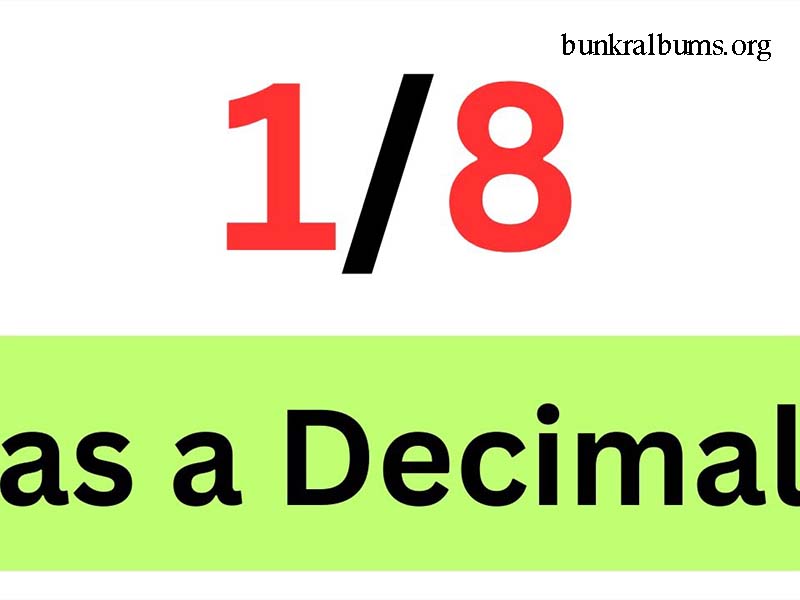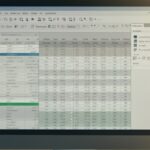Understanding fractions and their decimal equivalents is essential in various areas of life, including mathematics, finance, and everyday calculations. In this article, we will focus on one such fraction: 1/8 as a decimal. Whether you’re a student trying to solve math problems, a professional needing accurate calculations, or simply curious about converting fractions to decimals, this guide will explain everything about the conversion of 1/8 to decimal form.
What Does 1/8 as a Decimal Mean?
Before diving into the conversion of 1/8 as a decimal, let’s break down what this fraction represents. A fraction is essentially a part of a whole. The top number (numerator) indicates how many parts you have, while the bottom number (denominator) tells you how many equal parts the whole is divided into. So, in the case of 1/8, we are dividing one whole into eight equal parts, and we’re focusing on one of those parts.
When we convert this fraction into decimal form, it will represent a portion of a whole in base-10, which is a more familiar format for most practical purposes.
How to Convert 1/8 as a Decimal?
The process of converting a fraction like 1/8 into a decimal is straightforward and can be done using long division. Essentially, you divide the numerator (1) by the denominator (8). Let’s go through this step-by-step:
- Divide 1 by 8: Start by dividing 1 by 8. Since 8 is larger than 1, the result will be a decimal.
- Add a Decimal Point and Zeros: Place a decimal point in the result and add zeros to the dividend (the 1 in this case) to allow for further division.
- Perform the Division: Divide 10 by 8, which equals 1 with a remainder of 2. Then, continue by bringing down another zero, making it 20.
- Continue the Process: Divide 20 by 8, which equals 2 with a remainder of 4. Bring down another zero, making it 40.
- Divide Again: Divide 40 by 8, which equals 5 with no remainder.
Thus, 1/8 as a decimal is 0.125.
Importance of Knowing 1/8 as a Decimal
Understanding the decimal equivalent of fractions like 1/8 as a decimal is useful for many reasons. Whether you’re involved in cooking, carpentry, engineering, or even shopping, converting fractions to decimals helps in making precise measurements and decisions.
For instance, in recipes, you might encounter measurements like 1/8 of a cup or teaspoon. If you’re working with a digital scale or calculator, converting this to 0.125 makes your job easier. The same goes for construction or DIY projects, where measurements often need to be precise to ensure the best fit and finish.
1/8 as a Decimal in Everyday Applications
Let’s explore how 1/8 as a decimal is used in various real-world scenarios:
- Mathematics: In school or academic settings, students often deal with fraction-to-decimal conversions. Understanding that 1/8 equals 0.125 simplifies solving equations that involve fractions. It can also be helpful when comparing or adding numbers in decimal form.
- Finance and Money: When dealing with percentages or financial figures, fractions like 1/8 come up frequently. For example, a discount of 12.5% is essentially 1/8 of the original price. Knowing 1/8 as a decimal (0.125) makes it easier to calculate savings or discounts.
- Measurements and Conversions: Fractions like 1/8 are often used in measurements, particularly in recipes, construction, and sewing. Converting 1/8 into a decimal helps when using metric systems or digital measuring devices. For example, in sewing, you may need to convert fabric measurements from inches to centimeters, where decimal equivalents come in handy.
- Technology and Engineering: In many technical fields, precision is key. Engineers and technicians often need to convert fractions like 1/8 into decimals to make exact calculations in designing machines, circuits, or even building structures. Using 0.125 instead of 1/8 ensures clarity and reduces errors when working with computer programs or digital tools.
Related Decimal Conversions
To better understand 1/8 as a decimal, it’s helpful to look at other common fractions and their decimal equivalents. Here are a few examples:
- 1/4 = 0.25
- 1/2 = 0.5
- 3/4 = 0.75
- 1/16 = 0.0625
- 1/32 = 0.03125
Knowing these conversions allows for quicker calculations in everyday situations. It also highlights how 1/8 as a decimal fits into the broader system of fractions and decimals.
The Role of 1/8 as a Decimal in Fractions
Fractions are an essential part of mathematics, and converting them into decimal form makes them easier to work with, especially when performing complex calculations or solving algebraic problems. In the context of 1/8 as a decimal, it is part of a larger group of fractions with denominators that are powers of 2, such as 1/4, 1/16, and 1/32. These fractions have exact decimal equivalents, which makes them particularly useful in calculations.
For example, when working with a ruler, measurements like 1/8 of an inch are commonly used. In this context, 1/8 as a decimal is helpful because you may need to add or subtract measurements using a calculator, and converting everything to decimal form ensures accuracy.
Tips for Memorizing 1/8 as a Decimal
While you can always use a calculator to find the decimal equivalent of fractions like 1/8 as a decimal, it’s useful to memorize a few common conversions. Here are some tips to remember that 1/8 equals 0.125:
- Think of Money: If you imagine dividing $1 into 8 equal parts, each part would be worth $0.125. This association with money makes it easier to remember.
- Use Fraction Patterns: Recognize that fractions with denominators of 8 follow a pattern when converted into decimals. For instance, 1/8 = 0.125, 2/8 = 0.25, 3/8 = 0.375, and so on.
- Practice Conversions: The more you practice converting fractions like 1/8 into a decimal, the more familiar you will become with the process.
Why 1/8 as a Decimal Matters
In conclusion, understanding 1/8 as a decimal is more than just an academic exercise. It’s a practical skill that is used in everyday life, from shopping and cooking to finance and engineering. The ability to convert fractions into decimals makes calculations easier and more precise, and knowing that 1/8 equals 0.125 can save time and reduce mistakes in various applications.
Whether you’re solving math problems, making decisions based on percentages, or ensuring that your measurements are correct, converting 1/8 as a decimal is a valuable tool. By mastering this simple conversion, you’ll be better prepared for a wide range of tasks in both personal and professional settings.
Understanding how fractions and decimals are interconnected will help you navigate a world where precision and accuracy are essential, making this small but important conversion an essential part of your mathematical toolkit.







